人教版新目标初中英语七年级上册Do you like bananas说课稿2篇
-
- 页数:15页
- 字数:约 15976 字
- 大小:88.00KB
- 格式:.doc
- 版本:Office2016及以上版本
- 作者:大猫丶演示
Do you like bananas说课稿2篇
Do you like bananas说课稿一
单元教材分析:
本课包括三部分:Section A, Section B和 Self-check.
主题: Food.
语言功能: Talk about likes and dislikes.
询问某人是否喜欢某种食物及回答;表达喜欢什么和不喜欢什么。

语言结构: Present tense to like Yes/No questions and short answers
Affirmative and negative statements
like 的一般现在时,一般疑问句及肯、否定回答;肯定句和否定句。
语言目标: 主要语法
Do you like hamburgers? Yes, I do. No, Idon’t.
I like French fries. I don’t liketomatoes.
Main vocabulary(词汇): hamburgers, tomatoes, broccoli, Frenchfries, oranges, ice cream, salad, bananas, eggs, strawberry, carrots, apples,chicken, breakfast, lunch, dinner, fruit, vegetable.
品德:在平日饮食中要做到不挑食。
根据需要可以分为四课时来讲
第一课时:
I.教材分析:这是本单元的第一部分,生词比较多,但是因为涉及到吃的东西,每个同学都有自己的爱好,学生比较感兴趣。
Language topic: Do you like bananas?
Yes, I do. No, I don’t.
Language strategies: Talk about likes anddislikes.
Main vocabulary: food, banana, hamburger,tomato, broccoli, French fries, strawberry, orange, ice cream, salad
II.语言结构: like的一般现在时的一般疑问句及回答。
III.语言功能:询问某人是否喜欢某物及怎样回答.
IV.活动设计:采访调查 Do you like…?
V. Teaching steps:
Step 1:Greetings.
Step 2: Words: (pictures)
What’s this? (picture) It’s a soccer ball.Do you have a soccer ball? Yes, I do. /No, I don’t. Do you like it? Yes, Ido./No, I don’t.
What’s this? It’s a hamburger. Do you likeit? Yes, I do. No, I don’t.
What are these? They’re bananas. Do youlike bananas? Yes, I do. / No, I don’t.
运用图片和对话教学单词:hamburger, banana, tomato, broccoli,French fries, strawberry, orange, ice cream, salad 并运用这些单词进行对话:Do you like…? Yes, I do./ No, I don’t.
Step 3: 1a Match the words with thepictures. (P31)
Step 4: 1b Listen and number theconversations 1-3.
Do you like salad? No, I don’t. Do youlike bananas? Yes, I do.
Do you like oranges? Yes, I do.
Practicethe conversations, and then make your own conversations.
Step 5: 2a Listen and circle the food youhear. (P32)
hamburgers tomatoes broccoli French friesoranges ice cream salad bananas
Step 6: 2b Listen again and fill in theblanks.
I like hamburgers. Do you like hamburgers?Yes, I do.
Do you like______: No, I don’t like______.
Let’s have _______. Oh, no. I don’tlike_________.
Step 7: 4 (P33)Make a food survey. Do youlike…?
Food
like it
doesn’t like it
tomatoes
Liu Li
Zhao Jun
hamburgers
bananas
French fries
broccoli
salad
oranges
How many students like hamburgers?
How many students like bananas?
日常生活中饮食要做到不偏食,不挑食。
Step 8: Let’s sum what we have learnedthis class.
Words:
Sentences:
Something else:
Step 9: Homework
1. Remember the words in this class.
2. Practise the dialogue in pairs.
教后一得:教完这堂课,感慨颇多。以前经常埋怨学生厌学,没兴趣,从这节课来看,主要是教师没有认真的去备课,没有去从学生的角度去处理教材,学生当然没兴趣。这节课,以学生的日常生活为话题,学生积极踊跃参加,效果很好,自我感觉良好。
第二课时:
I.教材分析:这是本单元的第二部分,生词也比较多。
Language topic: Does he like salad? Yes,he does.
Does she like salad? No, she doesn’t.
Language strategies: Talk about likes anddislikes.
Main vocabulary: egg, apple, carrot,chicken, fruit, vegetable, breakfast, lunch, dinner
II.语言结构: like一般现在时第三人称单数的一般疑问句及回答。
III.语言功能:询问第三人称是否喜欢某物及怎样回答.
IV.活动设计:Guessing game
V. Teaching steps:
Step 1:Greetings.
Step 2: Words: (由对话引出)
(Ask a boy)Do you like bananas? Yes, I do./ No, I don’t.
(Ask another student) Does he likebananas? Yes, he does. / No, he doesn’t.
(Ask a girl)Do you like eggs? Yes, I do. /No, I don’t.
(Ask another student) Does she likebananas? Yes, she does. / No, she doesn’t.
依次类推 chicken, apple, carrot, fruit, vegetable.
Do you like eggs for breakfast? Breakfastis the first meal of a day.
Do you like vegetables for lunch? And doyou like chicken for dinner?
(转到第三人称) Does he or she like carrots for lunch? Yes, he does./No, hedoesn’t.
Ask the students to remember the newwords.
Step 3: 1a Write the number in the boxnext to the correct food. (P34)
1.broccoli 2. salad 3. eggs 4. apple 5.ice cream 6. hamburger 7. banana
8. orange 9.carrots 10. chicken
Step 4: 2a Listen and circle the wordsfrom 1a that you hear. (P34)
Step 5: 1b How many other words can youadd to the lists? (P34)
Fruit: apples
Vegetables: broccoli
Add five new words to your Vocab-Builder.Ask the students to remember them.
Step 6: Write down what your family liketo eat.
My father: eggs, apples…
My mother: chicken, oranges, carrots…
My sister: hamburgers, ice cream…
My brother:
Ask another student to guess: What does myfather like?
Does he like vegetables? No, he doesn’t.
What does my sister like? Does she likeice cream? Yes, she does.
Step 7: Let’s see what we’ve learnedtoday.
Words:
Sentences:
Something else:
Questions:
Step 9: Homework.
1. Remember the words.
2. Practise the dialogue in pairs.
3. Finish the workbook.
教后一得:这节课不如上一节课效果好。原因是:今天我的情绪不好,把自己的个人情绪带到了课堂,这样是不对的。教师应当以饱满的热情来影响学生,调动学生,从而收到良好的课堂效果。
第三课时:
I.教材分析:
Language topic: I like oranges. I don’tlike bananas.
They like salad. They don’t like broccoli.
He likes hamburgers. He doesn’t likebroccoli.
She likes ice cream. She doesn’t bananas.
Language strategies: Talk about likes anddislikes.
Main vocabulary: eat, running star, lotsof, healthy, food, dessert, list
II.语言结构: like一般现在时的肯定句和否定句。
III.语言功能:怎样表达喜欢什么和不喜欢什么.
IV. Teaching steps:
Step 1:Greetings.
Step 2: Practise dialogue like this:
Do you like bananas? Yes, I do. I likebananas.
Do you like salad? No, I don’t. I don’tlike bananas. I like salad.
Practise in groups: I like …, I don’tlike. 转到第三人称
Ask another student: Does he like salad?No, he doesn’t. He likes bananas.
Step 3: 3 (P33) Pair work. Find out what/Bill and Bob like and don’t like.
French fries strawberry salad ice cream
Bob
Bill
Practise like this: Bob likes Frenchfries. He doesn’t like salad.
Bill likes …
Step 4: 2b Listen and fill in the chart.(P34)
Likes doesn’t like
Katrina: apples carrots
Tom:
Ask and answer questions about whatKatrina and Tom like and don’t like.
Step 5: 2c Look at the breakfast, lunch,and dinner in activity 1a. Are they Katrina’s or Tom’s? Write K or T (P34)
Step 6: 3a Read the article and underlinethe fruits and the vegetables. (P35)
Runners eats well!
Middle brook High running star KatrinaPedrosa eats lots of healthy food. For breakfast, she likes eggs, bananas, andapples. For lunch, she likes hamburgers, salad, and oranges. And for dinner,she has chicken, tomatoes, French fries and, for dessert, ice cream.
New words: eat, running star, lots of,healthy, food, dessert
(有些单词让学生会读即可。)
Step 7: 4a You are going on a picnic witha group of friends. Make a list of food to buy. (P35)
I like apples. Do you like apples? Yes, Ido. Do you like oranges?
Yes, I do. What do they like? …
Then read your list of food to the class.
Step 8: Let’s see what we’ve learnedtoday. (Ask the students to sum by themselves)
Words:
Sentences:
Something else:
Questions:
Step 8: Homework.
1. Ask the students to remember the newwords.
2. Practise the dialogue in pairs.
2.Exercises.
教后一得:本单元主要学习如何表达喜欢什么和不喜欢什么,对于这一话题,学生非常感兴趣,通过教给学生一些食物名词,并适当补充一些日常用到的名称,进行对话练习,学生热情高涨。
第四课时
Self-check (Revision)
I.教材分析:这是本单元的最后一部分: Self-check,即本单元的复习部分。这一部分的课本是由以下几部分组成的。
1.Key word check. Check the words youknow.
2.Add five new words to yourVocab-builder.
3.Draw the food you like to eat for lunch.
4. Ask your classmates what they like toeat for lunch. Find someone who likes to eat the same lunch as you.
Just for fun! Do you like broccoli?
II.这一部分可分为如下几个步骤进行:
Step 1:Review words like this:
Food: chicken hamburgers French fries icecream
Fruit: apples bananas oranges
Vegetables: salad carrots tomatoes
Ask the students to remember them andcheck up.
Step:II. Practise the language topic (P32)Grammar Focus.
Doyou like salad? Yes, I do. No, I don’t
Do they like salad? Yes, they do. No, theydon’t.
Does he/she like salad? Yes, he/she does.No, he/she doesn’t.
I/Theylike oranges. I/They don’t like bananas.
He/she likes ice cream. He/She doesn’tlike bananas.
Stop III. Write about what Tom likes toeat for breakfast, lunch, and dinner.
For breakfast, Tom likes eggs, oranges,and bananas. For lunch, he likeshamburgers,____________________________________. And for dinner, he likes______________________________________.
Step IV. Write about what you like forbreakfast, lunch and dinner.
Step V. Draw the food you like to eat forlunch.
Step VI. Ask your classmates what theylike to eat for lunch. Find someone who likes to eat the same lunch as you.
Step VII Fun (Ask the students to read thedialogue in a strange voice to make more fun)
Step VIII. What you have learned from thisUnit.
Questions:
Homework: 1. Remember all the words inthis Unit.
2. Practise the dialogue in pairs.
3. Finish the exercises about this unit.
教后一得:本课时回顾、练习了本单元的教授内容,通过练习,进一步巩固了本单元的所学内容,进一步设计活动来完成本单元的教学任务,但切忌避免机械地重复,活动应本着由简到繁的活动设计原则。
第五课时
教学内容是Section B的3a,3b, 4 三个部分。形式为广告,但主要内容是描述衣服及其价格。单词:clothing, store, sale, time, year, again,fantastic. Price, cheap, all, each, or, just, believe, come, down, come downto, yourself, cool, goods, buy, from, sell。教学目的:通过学习该部分,学生能够简单描述衣服,并为自己的服装店做个广告。
教学过程:
I. Revision.
Show the pictures of the clothing. Let’sread and spell the names.
Ask the price according to the pictures.
II. Do the reading practice.
3a Read the ad and fill in the price tags.
Do the ask-answer exercises in pairsaccording to the prices in 3a.
III. Learn the new words.
Listen to the tape and repeat.
clothing, store, sale, time, year, again,fantastic, price, cheap, all, each, or, just, believe, come, down, come downto, yourself, cool, goods, buy, from, sell
III. Task.3b
1.You have a clothing store next toHuaxing. We go to your shop. Please answer our questions about the prices ofthe clothing.
2. Then write your own ad. The beginninghas been given.
Mr Cool’s Clothing Sale
Come to Mr Cool’s Clothing Sale. Thesesocks are only 5 dollars. Do you like…?
IV. Task. 4
Groupwork
Your group is having a sale. You each have200 RMB. You can buy or sell anything you like. Make a note of what you buy orsell.
Names
Goods
Buy from
Sell to
Price
本节课是个检测课, 是对本单元所学习的内容的全面复习和检测。包括新单词:zigzag, clothes, shop, yellow, ask, which,新短语:have a look, 日常用语:I’m sorry.
1 Key word check. Check [√] the words youknow.
单词检测,可以根据实际,或由学生自己检测,或在教师的指导下检测, 由学生自己检测则可锻炼学生的自学能力。
2 Write five new words in yourVocab-builder.
词汇积累, 由学生自己独立完成, 锻炼学生的自学能力。
3为阅读检测,在规定的时间内完成后,集体批改答案。
该题含新单词zigzag clothes shop yellow ask which,短语 have a look,句子: I’m sorry.在做题过程中, 教师要对此进行讲述。
除了做好书上的题目以外,根据本单元的学习特点,我另外设置了以下题目:
1. 话剧表演 (课内完成):
分小组, 卖方一人和买方五人, 扮演售货员和顾客, 购买自己需要的物品, 先在小组内演练,最后到前台表演。
2. 写作和书写练习 (可在课后完成,由教师批阅):
为你的商店写一则简短的\有吸引力的广告。
教后一得:本节课是个检测课, 是对本单元所学习的内容的全面复习和检测。包括新单词:zigzag, clothes, shop, yellow, ask, which,新短语:have a look, 日常用语:I’m sorry. 学生掌握的很好。
Do you like bananas说课稿二
一、教学背景分析
(一)教学内容分析
本单元的中心话题是Food. 主要语言功能项目是Talk about likes and dislikes. 语法结构为Present tense tolike, Yes / No questions and short answers, Affirmative and negativestatements. 本单元Section A所呈现的是与谈论喜好与厌恶相关的基本语言知识及其初步运用。这部分内容从呈现食物词汇开始,通过视、听等方式输入信息,并引出本单元主要句型:Do you like…? 及其回答Yes,I do / No, Idon’t.接着设计了一个听力练习,要求圈出所听到的食物以及补全对话,强化记忆所学词汇和初学句型。然后教材设计了一个结对活动,以此操练主语是第三人称单数时句型的变化以及回答。并借此突出本单元的语法重点。最后教材设计的Food Survey起到了引导学生初步综合运用所学语言的作用,以调查的形式使学生在富有挑战性的活动中主动运用所学语言,落实新知。Section B是在Section A基础上的知识的扩展和延伸。本单元中,Section B首先以听、说、写的形式展开了食物与名称配对以及对食物进行分类。接着设计了听力填写Sandra和Tom喜欢与不喜欢的食物;自然引到了谈论一日三餐的话题的结对活动,实现了新旧知识的综合运用;一日三餐合理健康膳食引出同步阅读;之后的写一段话谈谈Tom 的一日三餐到写一段关于自己一日三餐喜欢吃的食物,直到最后的小组活动列出购物清单,使学生从完成半真实的任务转向了完成真实的任务,从而达到了创造性活用所学语言的目的。Self check部分的主要内容是对本单元主要词汇及语言运用能力的自我评价。
综上所述,本单元以食物为主线,围绕着谈论喜欢与不喜欢以及一日三餐等语言功能项目展开了一系列任务活动。教材内容从基本语言知识到语言综合运用层层递进,听说读写依次展开,以一种循序渐进的生活化的学习程序,引导学生在做事中有目的地学习语言。
(二)教学重点和难点
教学重点:1、掌握关于食物的词汇。
2、熟练运用所学功能项目谈论喜好和厌恶。
3、能准确地用英语描述一日三餐的食谱。
教学难点:1、交际用语Do you like bananas? Yes, I do. /No, I don’t.
2、描述一日三餐的方法。
3、一般现在时,主语是三单时,助动词与动词的变化。
4、可数名词和不可数名词的区别。
(三)教学目标
《新课程标准》之基础教育阶段英语课程的总体目标是培养学生综合语言运用能力,而这种综合语言运用能力的形成是建立在语言知识、语言技能、情感态度、学习策略和文化意识的整体发展基础上的,根据本课教学内容和学生知识结构及认知特点,本单元的教学目标确定为:
1、语言知识目标:立足语言实践活动,在完成任务的过程中掌握谈论喜好和厌恶以及表述一日三餐的词汇和语言结构。
2、语言技能目标:
(1) 开展多种任务型的听力活动,获得理解、识别和处理与谈论喜好、厌恶相关的信息。
(2) 展开各种任务活动,使学生具备较熟练地运用所学语言谈论喜好与厌恶,描述一日三餐的合理搭配的能力。
(3) 引导同步阅读,使学生理解与主题相关的语言材料,并增强学生运用语言获取更多信息的能力。
(4) 进行写作练习,使学生具备初步的综合运用语言的能力。
3、情感态度目标:
(1)通过情景的设置和活动的开展,引导学生在体验、实践、参与、合作和交流中,积极主动地学习语言,体会在做事中学习英语的喜悦。
(2)讨论美食,享受生活美味,提倡健康合理膳食。
4、学习策略目标:
(1)Disscussion. 通过小组讨论、开展调查等研究,明确在用中学、交流中学习的想法。
(2)Classifying. 通过分类法,可简化学习过程,利于记忆。
(3)Guessing. 通过猜测,并大胆发言,以学习新知。
5、文化意识目标:了解中西方膳食的不同习惯以及表示喜好与厌恶的一些常用表达法。
二、教学方法和学习策略
1、教法
(1)本单元话题源自生活,立足这一点,充分利用学生已有的知识和经验,创设生活化的真实(或半真实情景)引导学生在运用语言中学习语言,然后在学习新的语言知识后创造性地运用语言(为用而学,在用中学,学了用)。
(2)开展多种类型任务活动,提供给学生合作交流的空间和时间,促使学生为完成任务和同学进行合作,为完成任务进行探究学习。
您可能喜欢的文档
查看更多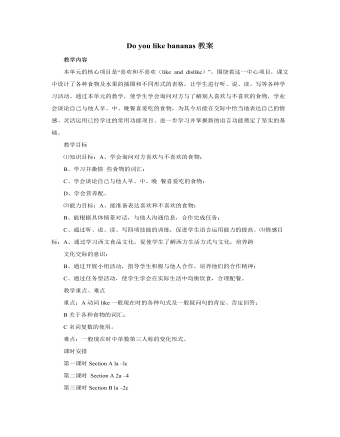
人教版新目标初中英语七年级上册Do you like bananas教案
- 页数:14页
- |大小:94.00KB
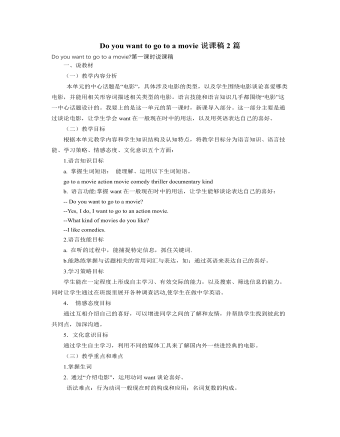
人教版新目标初中英语七年级上册Do you want to go to a movie说课稿2篇
- 页数:7页
- |大小:68.00KB
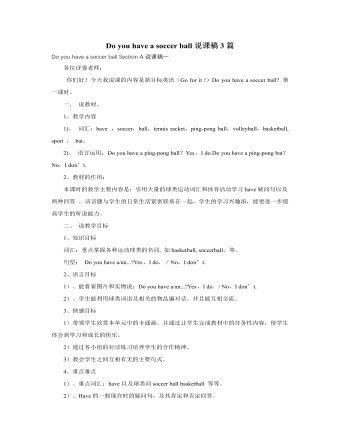
人教版新目标初中英语七年级上册Do you have a soccer ball说课稿3篇
- 页数:10页
- |大小:74.50KB
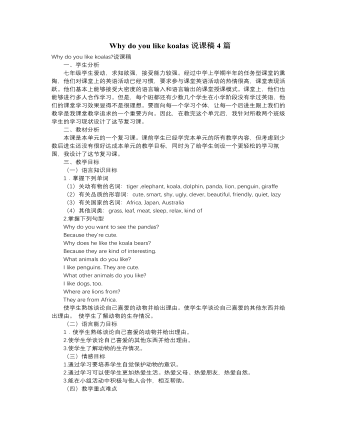
人教版新目标初中英语七年级下册Why do you like koalas说课稿4篇
- 页数:9页
- |大小:76.00KB
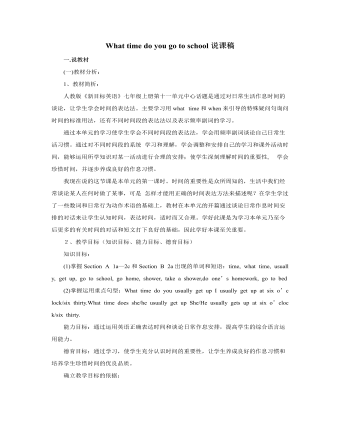
人教版新目标初中英语七年级上册What time do you go to school说课稿
- 页数:6页
- |大小:62.50KB
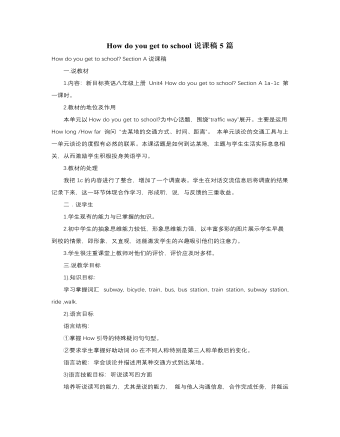
人教版新目标初中英语八年级上册How do you get to school说课稿5篇
- 页数:26页
- |大小:105.00KB
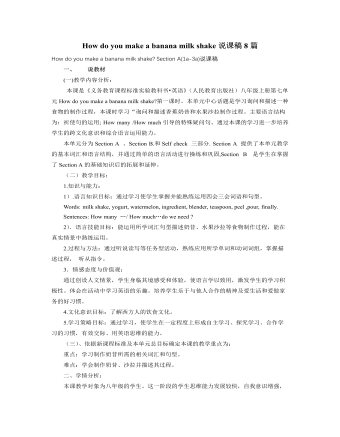
人教版新目标初中英语八年级上册How do you make a banana milk shake说课稿8篇
- 页数:25页
- |大小:123.50KB
热门说课稿
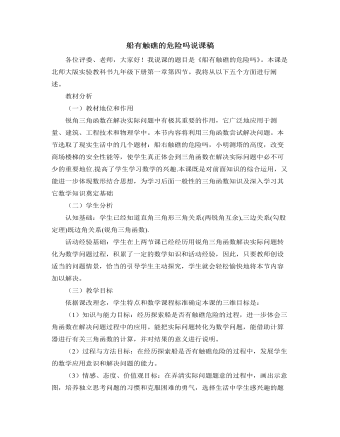
北师大版初中数学九年级下册船有触礁的危险吗说课稿
- 页数:5页
- |大小:43.50KB
- 说课稿

北师大版初中八年级数学上册三角形内角和定理说课稿2篇
- 页数:6页
- |大小:60.50KB
- 说课稿
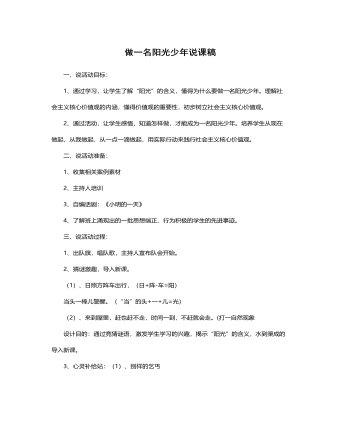
做一名阳光少年说课稿
- 页数:4页
- |大小:24.83KB
- 说课稿
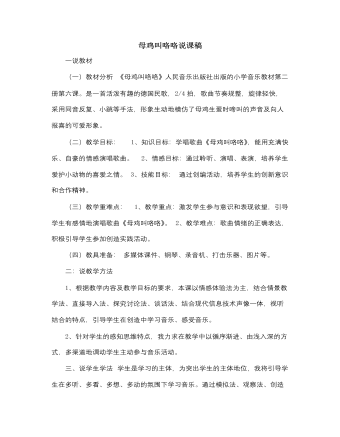
人音版小学音乐二年级上册母鸡叫咯咯说课稿
- 页数:4页
- |大小:38.00KB
- 说课稿
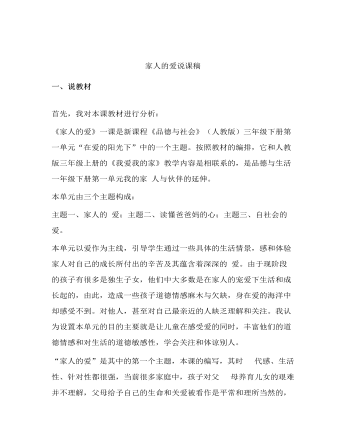
人教部编版道德与法制一年级下册家人的爱说课稿
- 页数:8页
- |大小:28.68KB
- 说课稿
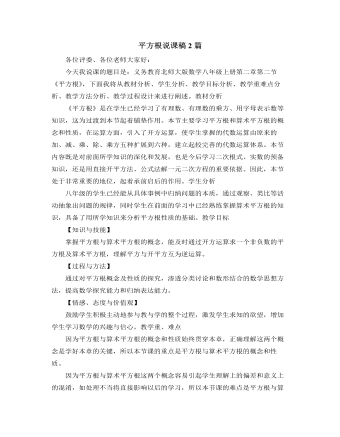
北师大版初中八年级数学上册平方根说课稿2篇
- 页数:8页
- |大小:51.50KB
- 说课稿
今日更新
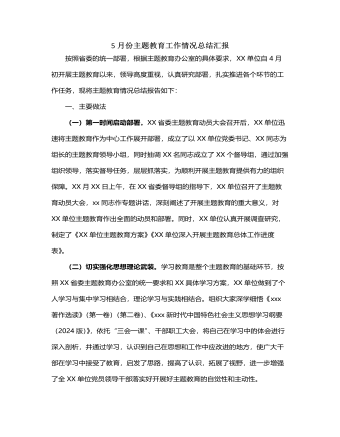
5月份主题教育工作情况总结汇报
- 页数:3页
- |大小:136.87KB

××县招商局2024年上半年工作总结
- 页数:12页
- |大小:142.54KB
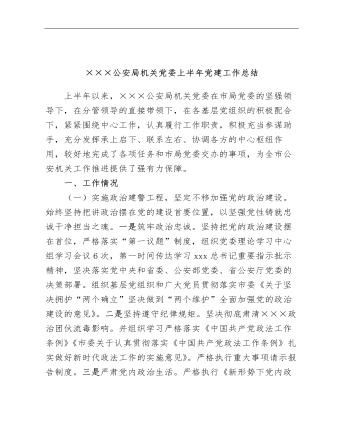
×××公安局机关党委上半年党建工作总结
- 页数:7页
- |大小:186.25KB

《2019—2024年全国党政领导班子建设规划纲要》实施情况的工作总结3800字
- 页数:6页
- |大小:29.16KB
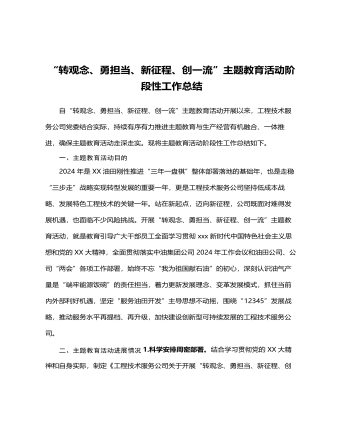
“转观念、勇担当、新征程、创一流”主题教育活动阶段性工作总结
- 页数:3页
- |大小:22.76KB

“四零”承诺服务创建工作总结
- 页数:5页
- |大小:39.83KB






